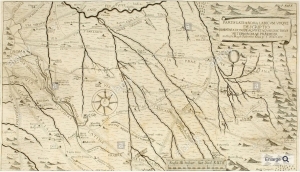
| For the photo's, see below |
| Home / the complete website |
The Aqua Alexandrina aqueduct is circa 22 km long. The source region can be located to the East of Rome at Pantano Borghese, immediately south of the ancient town of Gabii. The aqueduct runs from the very start relatively straight to the city of Rome, between the Via Prenestina and the Via Casilina (the ancient Via Labicana). On its way from east to west it has to cross many south-north running ridges, and valleys formed by tributaries of the Aniene (ancient Anio) river. As a consequence, pieces running above ground, often crossing the valleys on high arches or on double-arched bridges, alternate with those parts conducted underground. Fabretti's map from 1680 shows the path of the Aqua Alexandrina through the described territory very well.
|
Just before the GRA East of Via di Torrenova remains of the Alexandrina can be reached on a dirt road located about 200 m south of the intersection of Via Prenestina and Via di Torrenova. This road leads up to an abandoned farmstead and a gravel pit. The best route to these ruins, which are located just below the abandoned farmhouse, in the direction of Via Prenestina, is to leave the dirt road just before the abandoned farmstead and walk down the field to the left onto the valley floor downstream of the arches, which can then be approached from below. There are some substructions on the east bank of the stream that can be more easily reached by following the dirt road around the house and down past the gravel pit (taking the left fork in the road; the other leads south to a working farmstead). The original arcade here was 28 arches long, of which nine remain, five on the upper bank and four on the lower, separated by a gap of two fallen arches. From: P.J. Archer (1995): Guide to the aqueducts of Ancient Rome, pag. 111 |
|
The destination, a summary The destination of the Aqua Alexandrina waters is still in discussion. - The 'traditional' view is the Baths of Alexander Serverus, via the Porta Maggiore towards the Campus Martius; for this option is no hard evidence. - Dr. Coates-Stephens (1998, 176) put forward the idea that, instead, the Baths of Caracalla via the Aqua Antoniniana was the ultimate destination of the AA-waters. - Quite close to Stazione Termini, in the Via G. Tepe, are the remains of six arches in the style of the Aqua Alexandrina, heading for the Piazza Vittorio Emanuelle II. A third option: the AA joined one of the major aqueducts at the end of the Via degli Angeli, just north of the Banca d'Italia; the water was tapped again (via the Aquae Claudia or Anio Novus) in the area north of the Porta Maggiore to feed - via the arches in the Via G. Pepe - the Nymphaeum Alexandri, also known as the Trophies of Marius at the named Piazza: the terminus of the impressive but low levelled Aqua Alexandrina aqueduct. Height levels of the specus in meters asl (Tedeschi Grisanti 1992 fig. 3): Aquae Claudia and Anio Novus (at Porta Maggiore) over 65 m; arches along the Via G. Pepe / Via Turati: 62.83 m; supply at the Nymphaeum Alexandri: 62,27 m. New and even more detailed height measurements and analysis of the calcareous deposits / sinter will have to prove what was the supply of the Nymphaeum Alexandri and what the destination of the Aqua Alexandrina waters. Wilke D. Schram |
| Item | Info |
|---|---|
| Length | 22 km |
| Cross-section | 0.7 m - 1.0 m |
| Volume | Unknown |
| Gradient | 0.044 % |
| Period | Alexander Severus |
| Features |
|
| Recommended literature : |
|
| Recommended websites : |
|
| How to visit : | see above |
| HOME | More literature on more aqueducts | Last modified: August, 2019 - (webmaster) |